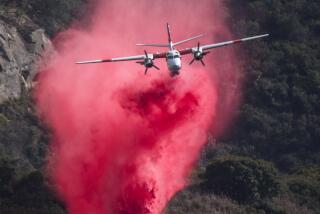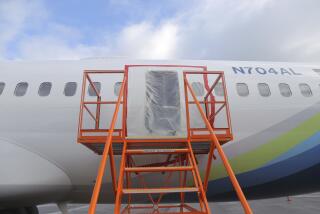For foreign correspondents, one phobia that won’t fly
ANTANANARIVO, MADAGASCAR — Clackety-clack. Clackety-clack. I pause as I mount the steps of the 737, frowning at the spinning engine.
“Does your engine always make that noise?” I ask the flight attendant while boarding the airplane from Antananarivo to the south of Madagascar. “Seat 5B,” he says. “On your right.”
A moment’s hesitation. I sit. (Mental image: flames shooting from the left-hand engine.)
The problem with having one of the world’s most interesting jobs and flying to the world’s most fascinating places is getting there.
Whenever I land, it’s fine. I plunge in, full of curiosity, and forget all about flying.
Accelerating down the runway on our flight from Antananarivo, the capital of Madagascar, the thundering momentum should be exhilarating. But for me it defines phobia: fear of flying.
Odd sounds send that fear soaring, like the midair thunking sound on a flight out of Liberia in 2005. Thunnnnk. Thunnnnk. Thunnnnk.
I asked the flight attendant what was thunking.
“It’s nothing. Just the air-conditioning compressor.”
Relief.
Then I thought of a recent international air catastrophe -- when the pilots on a 737 to Athens lost consciousness, reportedly because of a fault in the air supply system or decompression; 121 people were killed.
Choppers are even worse. Perhaps it was the helicopter flight I once took in Chechnya with the Russian military. We rose to about 300 feet and then descended abruptly to the ground.
“It’s normal, normal, totally normal,” I told myself.
Again we rose. I sat as far as I could from the massive interior fuel tank.
About 15,000 feet up, the chopper lurched sickeningly sideways. There was a moment of sagging equilibrium as it hovered before plunging with an alien metallic roar. (Mental image: fuel tank exploding in a ball of fire.)
At the last moment, the pilot dragged the machine from its descent and began skimming just a few yards above the ground, rising to avoid trees and electrical wires, dipping into valleys. Finally I understood. This was terrain flying, Russian-style.
And in Tajikistan, the world’s biggest chopper, the Russian Mi-26, nicknamed the Korova (“Cow”), took me up into the maze-like valleys of the Pamir Mountains, black peaks striped with snow like a herd of zebras. Clouds descended rapidly. It got so bad the pilot considered giving up and heading back to the Tajik capital of Dushanbe.
“Oh, come on,” his co-pilot said. “Be a man.”
As a child, I loved flying. But my first posting raised alarm bells: In January 1994, three months after I became a correspondent in Moscow, a flight from Irkutsk to Moscow crashed, reportedly because the pilot ignored a cockpit warning that the engine starter turbine wasn’t working. The engine burst into flames. All 124 people on board died.
Soon after, an Aeroflot flight from Moscow to Hong Kong crashed because the pilot let his 15-year-old son fly the plane. The flight data recorders revealed that the boy unknowingly disabled an autopilot function, sending the plane into a 33,000-foot, 4-minute death dive.
Every Moscow journalist had a terrifying story: flight attendants ferrying bottles of cognac into the cockpit; dual engine failures; emergency landings in the middle of fields when the fuel ran out; flights so cold that the beer passengers were drinking froze in their hands.
Two days before Christmas in 1994, I was flying to Vladikavkaz in southwestern Russia. As usual, a chaotic pack populated Moscow’s Vnukovo Airport, a grim place with a neglected air.
The plane, due to leave midmorning, was delayed for an hour. Then another.
At 5.30 p.m., a plane was suddenly found and we were rushed onboard by an attendant with big hair and bright butterfly wings of blue eye shadow, shrieking at people to take their seats. She unnerved me.
“This is normal, completely normal,” I told myself.
It was a Tu-134, the kind of plane that had an emergency rope, not a slide. I was in the row behind the emergency rope, sitting beside a friend and human rights advocate, Andrei Mironov, who’d survived three emergency landings and a helicopter that had hopped like a kangaroo on takeoff.
As we took off with an unearthly screech of what sounded liked tearing metal, my eyes kept straying to the huge bag a passenger had dumped in front of the emergency exit.
The pilot yelled through the scratchy intercom: “Put your seat belts on!”
As the plane struggled to gain height, I looked at Mironov and suggested we ask the guy in front of us to move his bag away from the emergency exit.
“Later” was all he said, meaning there wasn’t any point. Years later, he told me that he had been sure we were all going to die.
Minutes crawled by. The plane didn’t stabilize and seemed to be slowing. Outside, Moscow’s skyscrapers loomed like treacherous coral reefs.
I glanced at a seasoned war correspondent across the aisle, who’d survived severe shelling when covering the former Yugoslavia. She was crying.
But the Russian passengers were pulling out vodka bottles and plastic bags with brown bread, boiled eggs and roasted chicken legs, as if out on a Sunday picnic.
Suddenly, the nose of the plane dropped. We were going down over Moscow. The Russians didn’t notice.
Dropping the nose was the pilot’s last card. We didn’t have much height. He flew down to gain speed.
It worked. The plane gradually stabilized and we flew on. Mironov and I didn’t say much, that flight.
The pilot landed the airplane flawlessly in Mineralnye Vody, about halfway to our destination. Astonishingly, the passengers staged the only consumer revolt I ever saw in Russia, hammering on the pilot’s door, demanding that he take off again and fly us onward to Vladikavkaz.
Years later, in Madagascar, our 737 is airborne, soaring serenely above the rice paddies and rickety wooden houses of the capital. The plane is stable, there’s no metallic shriek, no ball of fire, the pilot doesn’t yell through the intercom, the flight attendants breeze about, and we land without incident.
I scuttle down the steps, shrugging off fear like a Russian winter coat unfit for the African heat. There are stories to dig out, discoveries to be made, people’s tales of struggle and inspiration.
I forget all about it. Until five days later, mounting the gangway stairs again.
--
More to Read
Sign up for The Wild
We’ll help you find the best places to hike, bike and run, as well as the perfect silent spots for meditation and yoga.
You may occasionally receive promotional content from the Los Angeles Times.






